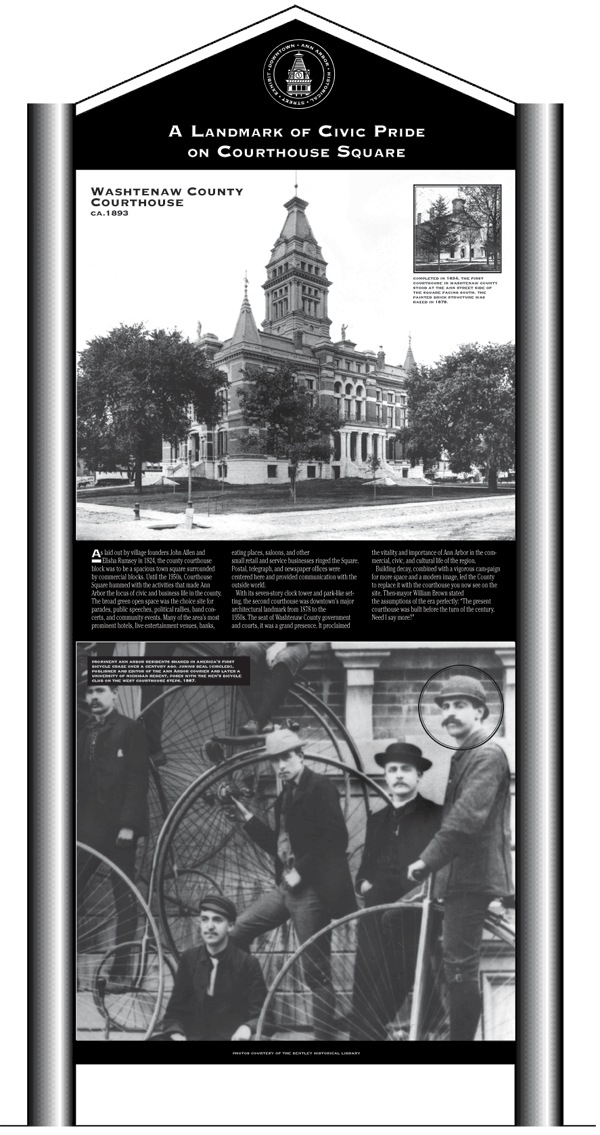Panel Information: Centers For Communications on Courthouse Square
Ann Arbor's early centers for communications, including newspaper, postal, and telegraph offices, were all located in buildings facing Courthouse Square. The telegraph line between Detroit and Ann Arbor was opened on Christmas Day in 1847. The first telephone switchboard was placed in a building not far from the Square on South Main in 1881. There were twenty-five telephone subscribers at that time.
From 1882 to 1909 Ann Arbor's sixth Post Office, at the corner of Ann and Main, was housed in what was the showiest building in town the Beal Block, an ornate brick edifice lavished with decorative stonework and iron filigree. Before home delivery began in 1886, every household in Ann Arbor picked up its mail here. In 1909 the Post Office was moved to the new classic Beaux Arts building still standing just to the north on the corner of Main and Catherine.
Site 7d. MAIN and ANN: southwest corner

Photos Courtesy of the Bentley Historical Library and the Ann Arbor News
|
Click within the image below for a closer look
|
|

Panel Information: Architecture & Business on Courthouse Square
By the late 1870s, Ann Arbor was a thriving and prosperous business center. The streets facing Courthouse Square contained some of the town's grandest commercial buildings. Originally, the northwest corner of Main and Huron was the site of a small, two-story, log block house built by town founder John Allen in 1824. Later expanded and painted bright red, Allen's former home was called "Bloody Corners." It housed a tavern, inn, and store before being replaced by Ann Arbor's first large hotel, the "Franklin House."
The imposing Gregory Block was built on this site in 1862. For over a century it provided space for a wide variety of establishments, including a hotel, banks, bars, bookstores, a post office, and Municipal Court offices. It became known as the Masonic Block when Masonic lodges occupied the second and third floors from 1885 to 1926.
By the time of its destruction in a 1971 fire, the Gregory Block's rich architectural details had been hidden under a façade of blue and white metal panels. The present building was constructed in 1986.
Site 7c. MAIN and HURON: northeast corner

Photos Courtesy of the Bentley Historical Library
|
Click within the image below for a closer look
|
|

Panel Information: Hospitality on Courthouse Square
Streets surrounding Courthouse Square were the site of most of Ann Arbor's largest hotels from the 1830s until 1990. Cook's Hotel was the first of five that have occupied this site. It was followed in 1871 by the larger "Cook House," a temperance hotel for 37 years. Renamed the "Allenel" in 1911 to honor town founder John Allen, it was demolished in 1964 to make way for the Sheraton, later the Ann Arbor Inn. The Allenel, a popular watering spot for local businessmen, politicians, and attorneys, was frequently used for banquets by local groups. It was a favorite lodging for visitors. Distinguished guests stayed in suites on the ornate top floor. The Philadelphia Orchestra stopped there during the annual May Festival.
Site 7b. MAIN and HURON: northeast corner

Photos Courtesy of the Bentley Historical Library
|
Click within the image below for a closer look
|
|

Panel Information: A Landmark of Civic Pride on Courthouse Square
As laid out by village founders John Allen and Elisha Rumsey in 1824, the county courthouse block was to be a spacious town square surrounded by commercial blocks. Until the 1950s, Courthouse Square hummed with the activities that made Ann Arbor the focus of civic and business life in the county. The broad green open space was the choice site for parades, public speeches, political rallies, band concerts, and community events. Many of the area's most prominent hotels, live entertainment venues, banks, eating places, saloons, and other small retail and service businesses ringed the Square. Postal, telegraph, and newspaper offices were centered here and provided communication with the outside world.
With its seven-story clock tower and park-like setting, the second courthouse was downtown's major architectural landmark from 1878 to the 1950s. The seat of Washtenaw County government and courts, it was a grand presence. It proclaimed the vitality and importance of Ann Arbor in the commercial, civic, and cultural life of the region.
Site 7a. MAIN and HURON: southwest corner
 |
This is the site of the central square and first courthouse that were the early focus of urban development and city life. The opera house, post office, activities of banks, law and title offices, and social life generated by nearby hotels, churches and the bus station all surrounded the courthouse and identified this as the center of town. |
Photos Courtesy of the Bentley Historical Library
|
Click within the image below for a closer look
|
|

SITE 7: COURTHOUSE SQUARE: ARTIFACT 3
Poster announcing the death of President Lincoln, April, 1865
|
Click within the image below for a closer look
|
|
SITE 7: COURTHOUSE SQUARE: ARTIFACT 2
Civil War Recruitment Poster
|
Click within the image below for a closer look
|
|

